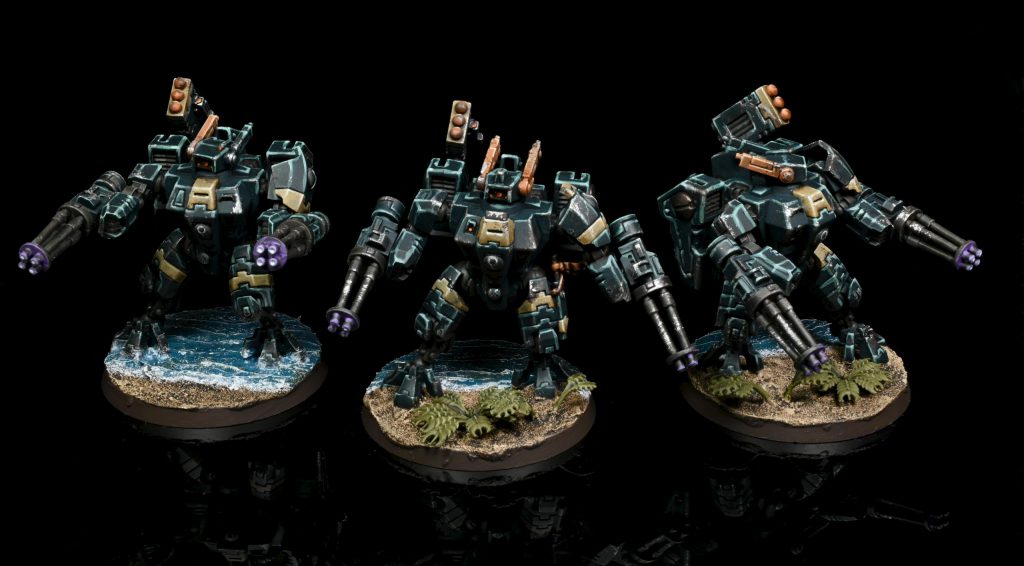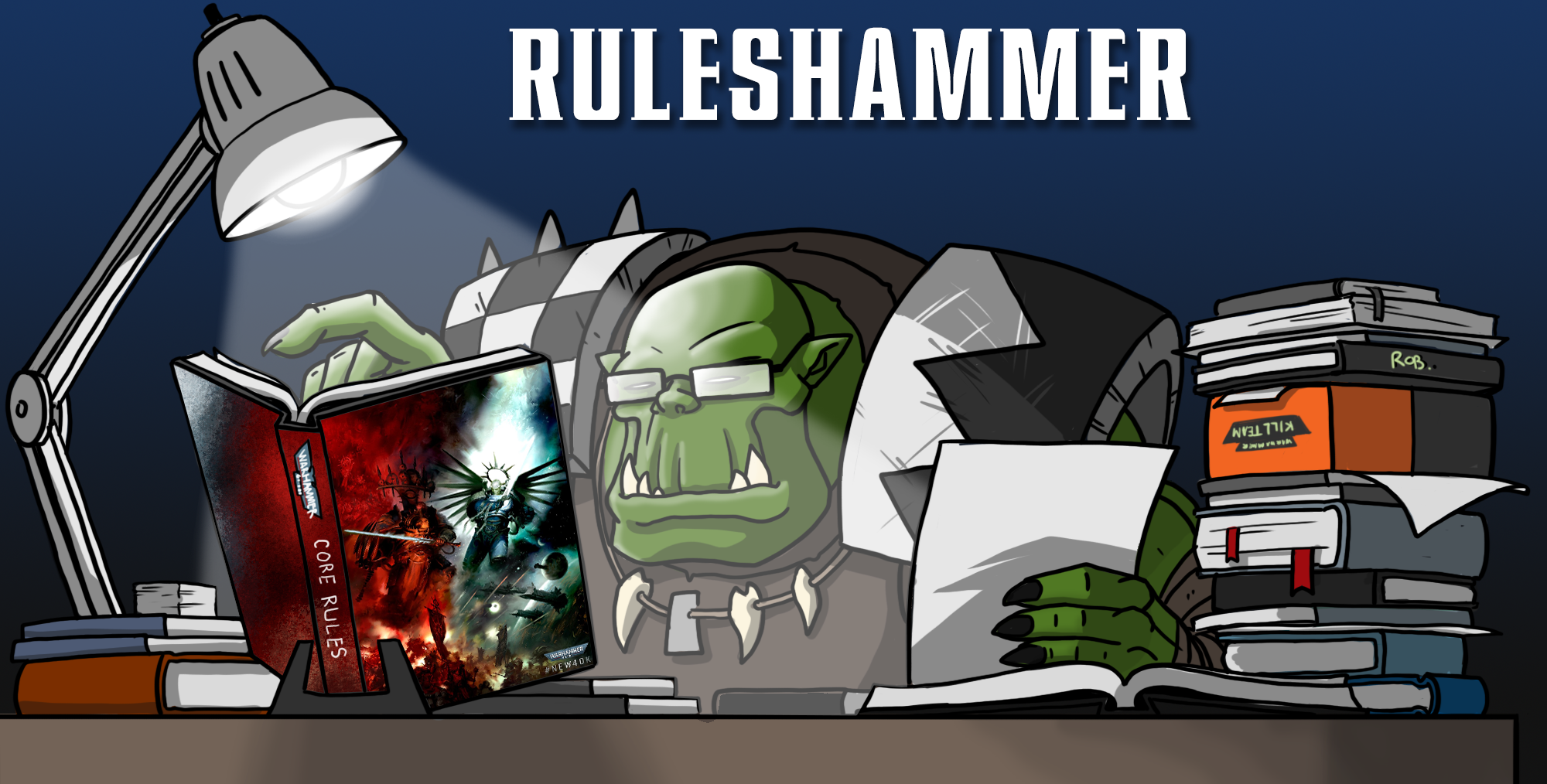Welcome to Ruleshammer! Something slight different this fitting in (mostly) with our mecha theme I’m going to be talking about Universal Special Rules… a term many might have heard from 40k’s sordid past that are making comeback!
What were/are Universal Special Rules?
USRs were and still technically are rules which Games Workshop deemed useful and common enough to make universal across all of the game’s factions – hence the name. These were pretty common in earlier editions of the game. An example: In 7th edition, rather than have a dozen differently-named abilities which might cause a unit to be able to fire Rapid Fire weapons at full range after moving (yeah moving used to reduce their range) instead the the unit would gain the Slow and Purposeful universal special rule. This rule was in the core rulebook.
If you’ve ever heard the term “deep strike” or “feel no pain,” those are are derived from the names for those rules in prior editions – these vestigial terms have lingered into 8th and 9th edition despite being replaced by dozens of rules with alternate names.
Some have come back in different forms, Blast was reintroduced in 9th edition but in earlier editions it was Special Weapon Characteristic, a Universal rule that applied to particular weapons. Something that previews for 10th edition indicate we may see a return the Twin-Linked rule if the datasheet we saw for Termagants was anything to go off of.
What Does This Have to do with Crisis Suits?
Through multiple editions of 40k, Crisis Battlesuits have been a medley of special rules, some Universal and some not. In honour of this year’s mech-inspired April Fool’s theme I thought we’d explore how the humble Crisis suit – the key battlesuit of the T’au Empire – has changed over time.
Jet Packs
3rd edition 40k did not have Jet Pack Infantry as a unit type; the closest equivalent was Jump Infantry. In these early editions these terms were not just keywords, they defined aspects of how the unit moved and interacted with terrain directly. Jump packs were well known but represented leaping across the battlefield one jump at a time, great for shock and awe Space Marines or Orks with axes but not really what the new combat-averse alien race seemed likely to be doing. And so Jet Packs were born, and became a Universal Special rule/unit type in 4th edition.
Until 8th edition a Jet Pack allowed a model to make a second move in the Assault Phase (back then the Charge and Fight Phases were merged into a single phase). The earlier editions of this rule had the distance be a set 6″ but 6th edition changed this to match the charge distance rule of 2D6″, making it possible for Jet Pack units to zip all over the board.
During 4th edition the Jet Pack rule also provided Crisis with their ability to shoot at full range with Rapid Fire weapons even after moving. Rapid Fire weapons had a fair few restrictions on them at the time.
Despite claims otherwise, Jump-Shoot-Jump – the name by which this rule was often referred, was entirely good and balanced and not annoying at all. Saying that, if I were to level some fair and balanced critique of the changes 8th brought to Crisis. Removing the extra move wasn’t unreasonable, but making Crisis slower than almost all Jump Infantry in the game… that was just mean. The 8″ move was a joke, and 10″ is barely making up for it! I’m fine.

Multi-Trackers and firing multiple weapons
Right up until 8th edition most models could only fire a single weapon they carried. The main exception to this were vehicles and monsters, which often could fire a combination of main and defensive weapons depending on the distance they moved that turn. Multi-trackers in those editions allowed a Tau Crisis suit to fire two whole weapons! Which was good because two was as many as they were allowed to take. You would still see Crisis suits back then with three weapons on them but two of those weapons would form a Twin-Linked pair.
You might be asking yourself why they did this if they needed to take the Multitracker to be able to fire both? Well in some codexes Crisis Suits could take certain support systems as a more expensive “hard wired” version where it was ostensibly the pilot getting the upgrade cybernetically. Doing this did not use up on the 3 hard points Crisis suits had at the time. Doing this was so prevalent than in the 6th edition codex Multi-trackers became standard issue equipment that were just part of the model having a Crisis suit in the first place.
In 8th edition the need for an upgrade to shoot more than one weapon became entirely unnecessary as being able to shoot with all weapons a model has became the standard rule for every model in the game (with the exception of Pistols).
Twin-Linked?
You may know a few players who have been through editions prior to 8th notice that the 10th edition preview datasheets listed Twin-linked as a note on a weapon profile. I also noticed that Assault and Pistol gained this treatment with shots now being separate to weapon type and allowing for multiple types on a single gun. In older rules Twin-linked allowed guns to re-roll hit rolls, but didn’t increase the number of shots. So Crisis suits would typically pay less for a twin-linked pair of weapons than they would for just two guns. In 8th edition this was removed as they just made twin-linked guns double the number of shots.
What Twin-Linked will do in 10th we can only speculate on. In 8th’s previews the removal of Twin-Linked was specifically accounted for by increases in attacks for those weapons, so a Twin-linked heavy bolter went from 3 to 6 shots, for instance. The previews we saw for Spine Fists however have the same 2 shots in their 10th datasheet as they do in their 9th one, so it’s less clear how the rule will work in 10th.

The Battlesuit rule and how it compares to Big Guns Never Tire
9th edition does have some USRs. They’re just not called USRs. It also has instances of having a Universal Rule for a thing and then not using it though, for instance the only changes between the Battlesuits ability and Big Guns Never Tire rule are the models to which the rules apply.
BATTLESUITS
BATTLESUIT models in this unit can make attacks with ranged weapons even when their unit is within Engagement Range of enemy units, but they can only make such attacks against enemy units that they are within Engagement Range of. In such circumstances, those models can target an enemy unit even if other friendly units are within Engagement Range of the same enemy unit.
Note that if a BATTLESUIT model has more than one ranged weapon, you can still choose to target units that are not within Engagement Range of its unit, but it will only be able to make the attacks with that weapon if all enemy units within Engagement Range of its unit have been destroyed when you come to resolve those attacks. In addition, when a BATTLESUIT model shoots a Heavy weapon, subtract 1 from the hit rolls when resolving that weapon’s attacks while any enemy units are within Engagement Range of that model’s unit.
BIG GUNS NEVER TIRE
A VEHICLE or MONSTER model can make attacks with ranged weapons even when its unit is within Engagement Range of enemy units, but it can only make such attacks against enemy units that it is within Engagement Range of. In such circumstances, VEHICLE and MONSTER models can target an enemy unit even if other friendly units are within Engagement Range of the same enemy unit.
Note that if a VEHICLE or MONSTER unit has more than one ranged weapon, you can still choose to target units that are not within Engagement Range of the firing model’s unit, but they will only be able to make the attacks with that weapon if all enemy units within Engagement Range of the firing model’s unit have been destroyed when you come to resolve those attacks. In addition, when a VEHICLE or MONSTER model shoots a Heavy weapon, subtract 1 from the hit rolls when resolving that weapon’s attacks while any enemy units are within Engagement Range of that model’s unit.
And the Battlesuit rule is itself only worded to be be specific to Battlesuit models so that Drone models in the unit can’t benefit from the ability. We can likely expect rules in 10th edition with its official return of Universal Rules to use language closer to “this model” rather than keywords, but really we’ll have to wait and see! I wrote more about this rule and some of it’s nuances here.
Have any questions or feedback? Got a rules question you want answered? Drop us a note in the comments below, ask a question in our Ruleshammer form, or head over to r/ruleshammer to discuss.



